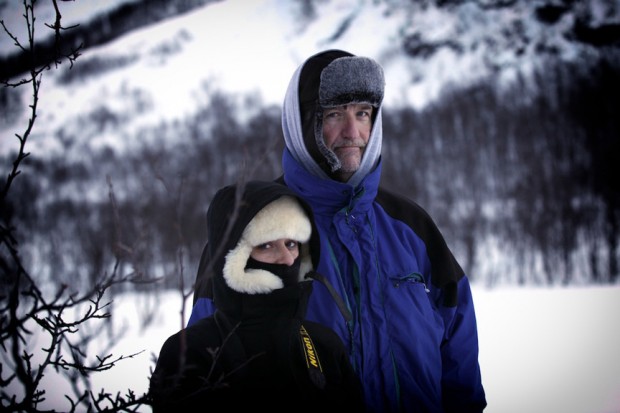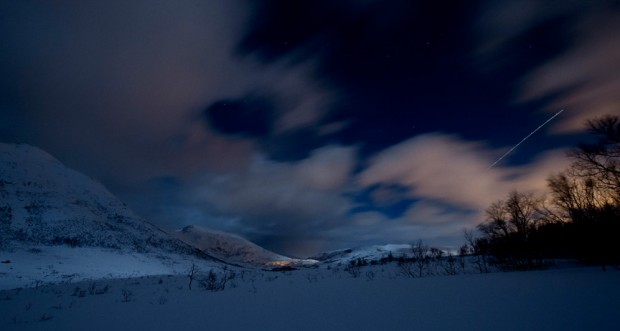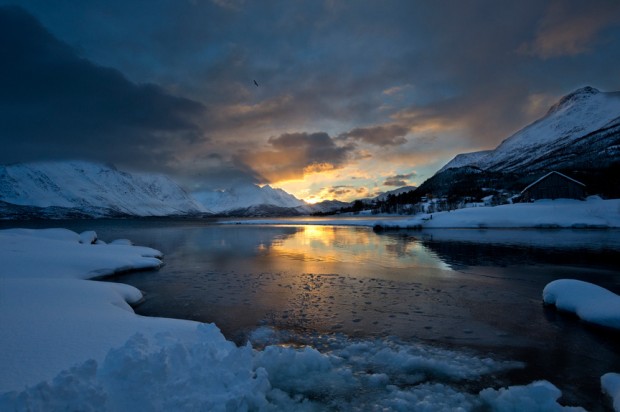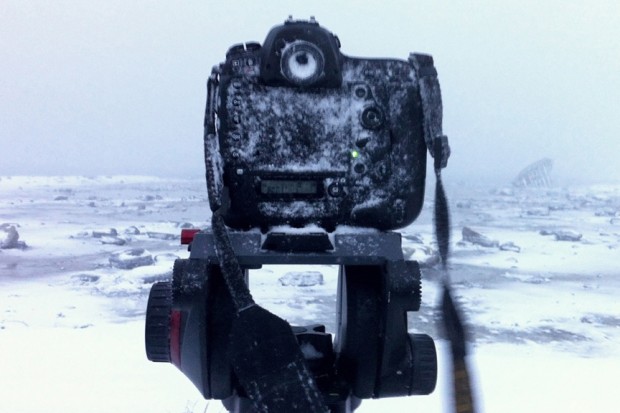
We came to Norway chasing the night light. Laura and I have been planning this trip for months. This was more than an assignment, this was a quest. We wanted to make a time-lapse video showing the Aurora Borealis–the Northern Lights.
We thought the light we sought would be green and dancing, and there was some of that. Mystical, almost spiritual waifs.
There is science behind the swirling bands of green. During large solar explosions huge quantities of particles are thrown from the surface of the sun into deep space. When the particles hit the Earth’s magnetic field they are drawn to an area around the magnetic North Pole creating the celestial green streaks of light.
But the real beauty to me was watching the bright full moon travel across the sky illuminating the mountains and fjords.

The night sky above the arctic circle is different. Rich and blue. Dark clouds racing across the night. Peaceful, tranquil, calm, and then the next minute massive amounts of snow and wind pelting us and the gear.
In Northern Norway this time of year the nights are long and the days are short. The sun is up for at most 4 hours a day, but you can only see it shining brightly for 10-15 minutes, if you’re lucky. It’s always night.

We had this well sorted out. We are on the road most years around 300 days and so we are fairly well organized, and certainly accustomed to packing for all kinds of contingencies. But seldom have we had to be concerned with keeping cameras and fingers warm enough to work in temperatures that can quickly drop to 20 below. Did I mention that we are from Florida?
We brought 5 tripods, 7 Nikon bodies, 9 lenses and a bunch of hand warmers. 6 extra batteries per camera. Rain covers to protect the bodies and lenses against the blowing snow. We learned after the first day that snow storms come quickly, sometimes when you are least expecting it.

The bag guys at Kata made some special cold weather pouches for us to protect bodes and more importantly batteries–I’m not sure if the bags made the difference or if the Nikon batteries just function perfectly in the temperatures, but I do know this: we didn’t have any issues with camera power. Even during 5 hour time-lapse captures.
Our buddy Andy Hancock was with us. Being a Texan he always does things a little, different, than we do. We were making most of our exposures for between 2 and 4 seconds, at f 2.8, ISO 1600. Andy decided to try 30 seconds, at f 16, ISO 1600. His images resonated with me–they had a blurred feeling that just worked. Since we had so many cameras running we had plenty of room, and time to experiment. We switched two of ours to 20 and 30 second exposures and loved the results for the time-lapse. As independent still images they are too soft for my use.
We fought the weather the first few nights. Dense clouds dropping heavy snow made it very tough to see the green lights we came to find.
It would have been easy to be frustrated and depressed. It’s not easy to get to Tromso–we traveled for almost 24 hours, and we had been planning this shoot for months. But it didn’t go that way. The calm, serene beauty and the light from the moon was enchanting. We had the best time, and made gorgeous images.
It’s what makes this job so difficult and so rewarding at the same time. When you are dependent on mother nature to produce, you are subject to her whims. It just reinforces what I have always said, you never know when the muse will strike, and when the stars will align to produce the best images in the toughest conditions.
Our next trip out to nature will be in March when we travel to Nebraska to host a workshop photographing the sand hill crane migration. We are excited to see what the weather has in store. Rain, shine, warm or cold, we are sure to be amazed and humbled.
You can see more of Bill’s work at BillFrakes.com and StrawHatVisuals.com, and follow him on Twitter



Bill, I lived in Fairbanks 10 years, loved that place. I remember seeing nothing but glowing eyes from all the animals in the woods! Awesome time lapse!
Great images, wonderful story. Thanks Bill and Laura.
Glad you got to see the nothern lights. It really is very special. I live further south in Norway, and get to see it now and then, but not often enough.
Bravo Bill and Laura!
Lovely! Nature does teach patience and humility, but the lesson is always worth it.
I enjoy your work and am looking forward to your book on Sports Photography.
Take a look at TSO’s work, a Norwegian timelapse photographer. http://vimeo.com/terjes
We went to Tromso 3 weeks ago. No moon at all and a very clear night. Waited for someblow clouds to blow through but a magnificent experience. Our guide is a photographer and he set ue up fast. Tripod, cable release, mirror lock, ISO 800, f4, 30 sec. No moonlight subdued the landscape butbletvthe stars come out in force. We will be back.